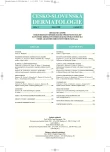Acute and Chronic Wounds – Etiology, Differences in Healing and Therapy
Authors:
A. Pospíšilová 1; M. Franců 2
Authors‘ workplace:
Dermatovenerologická klinika FN Brno a LF MU
přednostka prof. MUDr. Alena Pospíšilová, CSc.
1; Klinika popálenin a rekonstrukční chirurgie FN Brno a LF MU
přednosta prof. MUDr. Pavel Brychta, CSc.
2
Published in:
Čes-slov Derm, 83, 2008, No. 5, p. 232-244
Category:
Reviews (Continuing Medical Education)
Overview
Recently, patients with various types of wounds – acute, chronic, complicated and non-healing get more publicity in dermatology and in other fields of medicine.
Wound is characterized by damage of skin surface continuity and organism integrity.
Chronic wounds usually arise in tissues trophically altered by previous disorders of vascular, mainly venous origin. Topical noxious impulses e.g. pressure or radiation represent another possible causes. Chronic wounds heal by new tissue formation (per secundam healing) with corresponding anatomical structure and that is why their reparation is usually long and individually influenced by origin and extent of damaged tissue.
Chronic wounds comprise leg ulcers, bedsores, ulcerating tumours and various wounds with postoperative healing or another complications.
This review deals with classification of wounds, differences in acute and chronic wound healing and last but not least with wound therapy. Article focuses on the most common chronic wounds in dermatology – leg ulcers.
Key words:
wounds – classification – healing - therapy
Sources
1. Barclay, L. Consensus statement describes dressings for acute and chronic wound management. Arch. Dermatol, 2007, 43, p. 1291-1294.
2. Calliano,C. How to choose the right treatment and dressing for the chronic wounds. Nursing. Hordám, 2003, 10, p. 6-14.
3. Dowsett, C., Stello, E. The principes of chronic wound bed preparation and treatment. Br J of Nursing, 2004, 13 (15), suppl. p.1-7.
4. Enoch, S., Harding, K. Wound bed preparation: the science behind theremoval of bariers to healing. Wounds, 2003, 15 (7), p. 213-217.
5. Falanga, V. Classification for wound bed preparation and stimulation of chronic wounds. Wound Repair and Regeneration, 2005, 8, 5, p. 347-352.
6. Flanagan, M. Assessment criteria. Nursing Times, 1994, 90 (35), p. 76-88.
7. Flanagan, M. Wound management, Churchill Livingstone, New York, 1997, p. 203.
8. Fletcher, J. Wound bed preparation and the TIME principles. Nursing Standard, 2005, 20 , 12, p. 57-65.
9. Franců, M. Dekubity. Dermatologie. Dvouměsíčník pro praktické lékaře a pediatry. 2007, 1(2), p. 68-80.
10. Harding, KG., Morris, HL., Patel, GK. Healing chronic wounds. BMJ, 2002, 324 (19), p. 160-164.
11. Goldmann, R. Growth factors and chronic wound healing: past, prezent and future. Advance in Skin X Wound Care, 2004, 17 (1), p.24-36.
12. Hakl, M., Hřib, R. Farmakologická léčba chronické nenádorové bolesti. Interní medicína pro praxi, 2005, 2, p. 97-100.
13. Harris, IR., Yee, KC., Walter, CE., Cunliffe, WJ. Kearney, JN., Wood, EJ., Ingham, E. Cytokine and protease in healing and non-healing leg ulcers. Exp Dermatol, 1995, 4, p. 342-349.
14. Hess, CT., Kirsner, RS. Orchestrating wound healing: assessing and preparing the wound. Advances in Skin x Wound care, 2003, 16 (5) p. 246-263.
15. Chin, GA., Diegelmann, RF., Schultz, GS. Cellular and mollecular regulation of wound healing. In: Fallabela, AF., Kirsner, RS.: Wound healing. Taylor x Francis, Boca Raton, 2005, p. 723.
16. Kingsley, A. Proactive approach to wound infection. Nursing Standard, 2001, 15, 30, p. 50-58.
17. Kingsley, A. The wound infection continuum and its application to clinical practise. Ostomy/Wound management, 2003, 49, 7A suppl. p. 1-7.
18. Klüken, N. Venenerkrankungen. In: Földi M., Klüken N., Dollare, M. Praxis der Lymphgeffässung Venenerkrankungen. Stuttgart, Fischer Verlag, 1974, p. 65-146.
19. Lait, ME., Smith, LN. Wound management: a literature review. J clin Nursing, 1998, 7, p. 11-17.
20. MacLellan, DG. Chronic wound management. Austr prescr, 2000, 23, p. 6-9.
21. Müller, A., Ruzicka, T. Differentialdiagnose des Ulcus cruris. Hautarzt, 2001, 7, p. 593-603.
22. Navrátilová, Z. Etiologie ran v oblasti bérce. Referátový výběr z dermatovenerologie, 2007, Speciál-II, p. 37-45.
23. Pospíšilová, A. Obvazy nové generace. Čas Lék čes, 1998, 137, 9, p. 264-266.
24. Pospíšilová, A. Etiologie a diferenciální diagnostika bércových vředů. Trendy v medicíně, 2000, 2, p. 8-10.
25. Pospíšilová, A., Švestková, S. Léčba chronických ran. IDVZP, Brno, 2001, p. 72.
26. Pospíšilová, A. Bércový vřed – etiologie, diagnostika a léčba. Postgraduální medicína, 2002, 6, p. 604-610.
27. Pospíšilová, A. Komplexní pojetí léčby chronických ran. Čs Derm, 2005, 80, p. 82-86.
28. Resl, V. Hojení chronických ran. Grada publishing, 1997, p. 425.
29. Schultz, G.S., Sibbald, R.G., Falanga, V. et al. Wound bed preparation: a systematic approach to wound management. Wound Repair and Regeneration, 2003, 11, suppl.1, p. 1-28.
30. Slonková, V., Vašků, V. Přehled krycích prostředků. Referátový výběr, 2007, 49, Speciál II, p. 53-64.
31. Stadelmann, WK., Digenis, AG., Tobin, GR. Physiology and healing dynamics of chronic wounds. Amer J Surg, 1998, 176 (2), p. 26-38.
32. Stryja, J. Nebojme se nových klasifikací. In: Bureš I. Léčba rány. Galén, 2006, p. 78.
33. Švestková, S. Diferenciální diagnostika bércových vředů. Diagnóza, 1999, 45 (7) p.7.
34. Turner, V. Standartisation of wound care. Nursing Standard, 1991, 5 (19), p. 25-28.
35. Veverková, L., Kalač, J., Chalupník, Š., Wechsler, J. Endoskopické přerušení perforátorů. Prakt Flebol, 1999, 8 (4) p. 148-150.
36. Westbay, S. Wound care. St. Louis, 1986, p.205.
37. Winter, GD. Formation of the scab and the rate of epithelization of superficial wounds in the skin of the young pig. Nature, 1962, 193, p. 293-294.
38. Yager, DR., Neomeh, BC. The proteolytic environment of chronic wounds. Wound Repair, 1999, 7, p. 342-349.
Labels
Dermatology & STDs Paediatric dermatology & STDsArticle was published in
Czech-Slovak Dermatology

2008 Issue 5
Most read in this issue
- Papillae Coronae Glandis – Hirsuties Papillaris Penis
- Acute and Chronic Wounds – Etiology, Differences in Healing and Therapy
- Cutaneous Manifestations in Dialysed Patients with Chronic Renal Failure
- Czech Dermatology in the Beginning of the 20th Century
